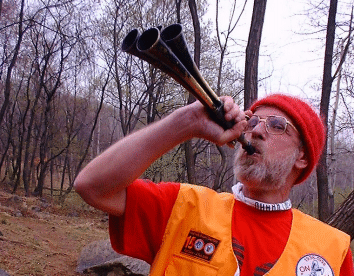It is the goal of all hash organizations to attract and develop a broad group of experienced hashers. Members of a hash take turns organizing and "setting" hashes for the group to enjoy each outing. Active hashers should plan to host and organize a hash themselves or with others from time to time.
The following guidelines are provided to help MASH hares in Seoul plan a successful hash! On! On!
Quoting from Half A Mind, Hashing: The Outrageous Running Sport written by a hasher in 1989: "It's important to keep before your mind's eye the goals of the hash itself. They are:
1. to offer an interesting interlude in the day's activities;
2. to get a pack of runners of various abilities through a chosen area (preferably your chosen area) without losing or speading them out or taxing them unduly;
3. to provide an opportunity for relaxed social interaction."
With that in mind and considering the special circumstances of living in this mega-populated metropolis that is Seoul, the MASH committee offers the following guidelines as you plan, organize, and host a MASH hash:
1. While trying to design and execute the perfect MASH hash, remember to relax a little and have some fun!! These guidelines are open for interpretation!
2. The ideal hash site is accessible both by car and public transportation with ample trails and a semi-private "on-after" area. Traffic is a problem so having a hash site that is accessible by a dependable subway-bus(shuttle) connection makes getting hashers to your hash much easier and less stressful for all.
3. Do lots of reconnoiterring around the area you are considering and look for connectable trails (and roads) that can make a fun hashing route. Good scenery is great and highly desirable but it is not a good idea to go up and down all the nearby hills. Think "running" not "climbing". Then do another recce! "Recce" in any language means walking/running lots of trails -- often stopping, turning around and going another way. Plan on 2-3 two-hour recces before you can begin to envision your hash routes.
4. After you have decided on your site, make a map or at least write clear directions for drivers and for using public transportation. Have someone else check your directions and try to time both the driving route (on a Saturday at hash time!) and using the subway from a central point like Seoul Station. Maps are nice but good directions are absolutely critical. Later we will develop a MASH hash site map that will show all of our sites thus making it easier for everyone.
5. Plan a runner's hash route and a separate walker's hash route. Each route should take about an hour to cover. Longer is better than shorter but around 90 minutes should be the limit. It is important that these separate routes not be too close to each other to avoid confusion. The runner's route will require markings and techniques called checks to keep the pack together. See illustration. We recommend you use the following hash marking conventions so everyone can understand your markings. Generally, a MASH hash route will start at point A and return to point A by a different route -- usually some variant of a loop. However, it is also good to vary the direction the route goes so it doesn't become predictable. In any case, the MASH horn will sound the horn occasionally to let everyone know the general direction of the leaders. Mark the walker's route so it can be easily followed or plan to have someone lead the walkers around. In a new area, you might want to do both.
6. It never hurts to have a sweeper for both the walkers and especially the runners to ensure hasher accountability. It's no fun to look for lost hashers in the dark!
7. When to mark your trail is contingent on many factors -- mainly available time to do so. It is usually best to mark your hash routes no earlier than the day before to avoid having it rained away or swept up by some conscientous Korean. It's a good idea to get a note written in Korean explaining why you are putting the markings down (unless you can speak Korean!) so you can show it to people who might otherwise "clean up" as soon as you move down the trail. Most Koreans respect fitness and like to see foreigners enjoying their hills and trails.
8. The "on-after" drinking and socializing is -for some- even more important than doing any running so a good site is very, very important.
9. Food is also highly desirable and reimburseable. It gives you yet another dimension to make your hosting truly memorable. More than a few hashes have been a little short or not-so-well marked only to be saved by great snacks afterwards! All is forgiven after a down-down or two!
10. Hares should plan to stay to the end or coordinate with the committee to police up the area afterwards so MASH doesn't develop a reputation for littering, etc.
Another quote from Half A Mind: "...a well-set course will provide both frustration and salvation without active participation of the hares." Generally, the hare and cohare run with the pack but do not offer advice or drop hints, unless absolutely necessary to prevent the hash from dissolving into total chaos! If they have set the hash route properly, hints shouldn't be necessary.
These quidelines are provided to assist anyone considering hosting a MASH hash. The committee is quite willing to offer further advice and guidance to ensure the mutual enjoyment of all involved. We are also quite happy to pair up enthusiastic new hashers with more experienced hashers to make future MASH hashes fun for everyone. So... if you have a potential site that you think would make a great hash, let us know and we'll help you make it a brilliant MASH hash. On! On! |



